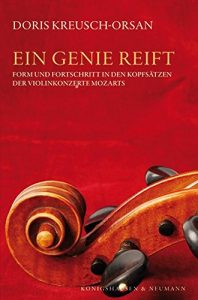A genius matures: form and progress in the opening movements of Wolfgang Amadeus Mozart’s violin concertos.
 Already in the series of WA Mozart’s violin concertos, which were written early, a stringent formal development process is evident, which fully expresses what came to full maturity in the instrumental concertos of the later years. The present book explores the question of the specific form of the opening movement in Mozart’s violin concertos. Subsequent to previous research results, the form model of the included sentences is described. In addition to the form model, the creative basic principles of contrast, increase and constant are pursued and it is shown how the heterogeneous clauses of the form model are linked to a homogeneous whole by the architectural principle of polarity, the procedural / dialogical principle of increase and the vertical principle of the constant.
Already in the series of WA Mozart’s violin concertos, which were written early, a stringent formal development process is evident, which fully expresses what came to full maturity in the instrumental concertos of the later years. The present book explores the question of the specific form of the opening movement in Mozart’s violin concertos. Subsequent to previous research results, the form model of the included sentences is described. In addition to the form model, the creative basic principles of contrast, increase and constant are pursued and it is shown how the heterogeneous clauses of the form model are linked to a homogeneous whole by the architectural principle of polarity, the procedural / dialogical principle of increase and the vertical principle of the constant.
Long overdue detailed analyzes show Mozart’s personal development within the violin concerto genre and enable a well-founded analytical comparison with the dubious violin concertos KV 268 and KV 271a.
In addition, previous research results on the question of the formal connection between aria and concerto are given a final answer.
Specialist book by Doris Orsan – published by Königshausen & Neumann, 264 pages.
https://www.amazon.de/Ein-Genie-reift-Fortschritt-Violinkonzerte/dp/3826044010
Book review of “A Genius Matures”
“The mystery of Mozart! Anyone who approaches him not only encounters paradisiacal soundscapes, but also a lot of superfluous things in the unmanageable music literature about Salzburg. A standard work is already the musicological introduction to Mozart’s violin concertos by the musician and author Doris Kreusch-Orsan. “A genius matures” is indispensable reading that reveals the magical moments of the music despite the clarity of the argumentation. The reader is made familiar with the traditions of the sonata principle and takes part in how Mozart, perhaps the greatest musical dramatist, sets contrasts, how the notes begin to sing. Especially since Doris Kreusch-Orsan, as a successful violinist, also knows the “craft” of playing and for that reason alone does not lose herself in the labyrinth of theories. It is always the practitioner who leads the Mozart novice as well as the specialist to the main topic of the respective introduction, illuminates secondary topics and their origins. You follow the text and, for example, in the A major violin concerto (KV219) you can hear it, deep inside, this abundance of beauty that almost hurts because it has to pass. Anyone who has a CD collection of the violin concertos will now be able to follow with all the stored knowledge how much the recordings by Jascha Heifetz, Anne-Sophie Mutter or Julia Fischer differ in their interpretation and the “Mozart experience” is another Gain dimension. “
Münchner Merkur / Manfred Stampa